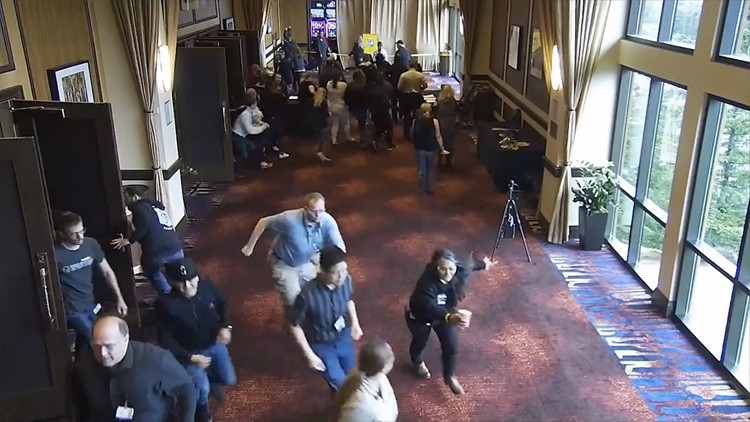Editor's Note: KING 5's Mark Wright took part in an active shooter training scenario this past summer. He describes the experience and shares what he learned.
We train for fires, earthquakes, and other disasters, so why don’t more of us prepare for mass shootings? It might sound paranoid, but it’s not.
Think of all the fire and earthquake drills we did as kids. When was the last time a child died in a school fire? A recent analysis found 288 school shootings have happened in the U.S. in just the past nine years.
Some companies are taking a proactive approach to this growing problem.
For one day in July, I took part in an active shooter training seminar for employees at the Snoqualmie Casino in eastern King County. The Casino CEO Brian Decorah allowed me, KING 5 photojournalist Joseph Huerta and KING 5 creative producer Mark Feijo to document it. We used a number of different cameras, including a virtual reality cam.
The training included scenarios that looked and felt like a real mass shooting. I have to be honest; I wasn’t sure how I would do.
Some of you know my son survived a mass shooting at a house party in our hometown of Mukilteo two years ago. The shooting took the lives of three young people. It rocked our community and my family. Since then, I’ve tried to engage people on the topic of gun violence because if we do nothing, the violence and death toll will continue to rise.
If it seems like mass shootings are happening more often, it’s not your imagination. Last year, a record number took place across the country. One hundred and thirty-eight people were killed, and nearly 600 others were wounded, in thirty separate shootings.
Decorah was in Las Vegas last October when a gunman opened fire on a country music festival — killing 59 people.
Ironically, Decorah was there for a gaming industry conference, and planning for active shooters was on their agenda. That’s when Decorah decided he needed to formally train his staff at the casino. So, he hired Tomahawk Strategic Solutions (www.tomahawkstrategicsolutions.com), a Nashville-based company created two years ago by former Navy Seals. They travel the world teaching companies, governments, police, and everyday people how to be ready for an active shooter.
For one day in July, Tomahawk instructors trained Decorah’s employees. It included classroom discussions and active shooter simulations that were very realistic.
One of the scenarios was a concert setting. The gunman stormed and started shooting blanks with a 9mm pistol. It was really intense. We all scrambled for safety by running from the ballroom out into the foyer or outside. Another scenario took place in the hallways of the executive offices. In the confined space, I can’t begin to describe how loud the shooting was. When the shooter was about 15 feet away from me, I could feel the air shock hit me with each blast. The reason they use gunfire to train is it puts pressure on you to think clearly under stress, and it gives you a good idea of what a gunshot sounds like indoors.
The first lesson that trainer Joe Collins told us was “we are the first responders.” Collins said, according to the FBI, the average active shooter incident lasts for 7 minutes. That means a shooting can start and end even before the police get there. And in many cases, we have just seconds to decide what to do.
Collins was the first SWAT team member to respond to the mass shooting at Virginia Tech in 2007 where a gunman shot and killed 32 people. He said a number of students froze and did nothing. Some were executed — still holding their cell phones as they called for help.
So what should we do?
The best strategy is to have a plan before the shooting starts. That means assessing the world around you throughout the day — especially the places you spend a lot of time, like at work. Where are the exits? Where are rooms with sturdy doors and deadbolt locks? Where are places to safely hide? What weapons can I use? The trainers told us fire extinguishers are good weapons. You can spray the dry chemical into the eyes of an attacker, and you can smash them over the head with one as well.
You don't want to have to think when the you-know-what hits the fan. You simply react.
The trainers told us to take that mindset with us wherever we go — restaurants, movie theaters, etc. It takes just a couple of seconds when you arrive to quickly scan your surroundings.
The next important lesson is: “Run, Hide, Fight.” It's the active shooter mantra. When the shooting starts, you will do one or all of these things, depending on your proximity to the shooter. If the shooter is right next to you, you’ll probably have to fight first. The trainers told us the goal is to create as much distance between you and the threat as quickly as possible. So, that could mean a combination of running, hiding and fighting … if it comes to that. They told us to always better our position, don’t check out. Call 9-1-1 when it’s safe to tell them where you are and where the shooter is.
Earlier, I mentioned that “we” are the first responders. That goes for medical aid as well. The most common way people die in mass shootings is they bleed out. Doc Harris, Tomahawk’s director of emergency medicine, is on a personal crusade to get tourniquet stations in public places and workplaces. You can improvise a tourniquet, but Doc said it’s much better to buy real tourniquets and get trained on how to use them.
>>Learn more about tourniquets by visiting Doc’s non-profit dedicated to the cause
The bottom line is you can dramatically improve your odds of surviving a mass shooting if you have a plan beforehand, and act when it happens. It starts by developing an awareness of your surroundings, and ask the question, “What would I do right now if someone started shooting?”
I ended up doing fine with the gunshots during the simulations, and I came away with a new sense of confidence. I now know what to do and have a new mindset to help me, should I ever need it.
Collins summed up our day of training by quoting Benjamin Franklin: “By failing to prepare, you are preparing to fail.”
What will you do to prepare?



